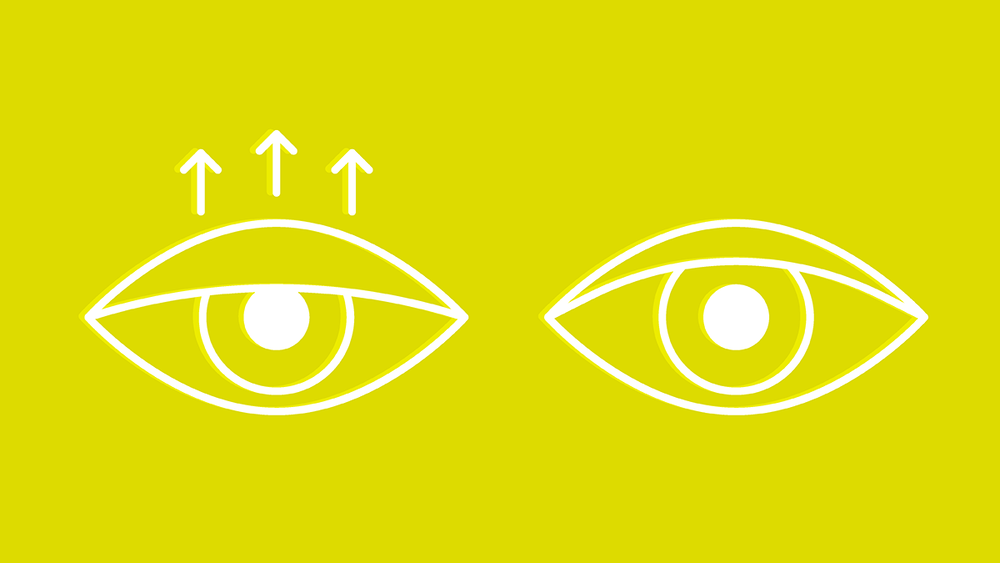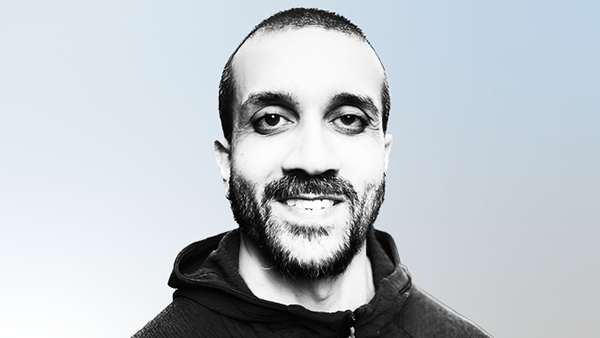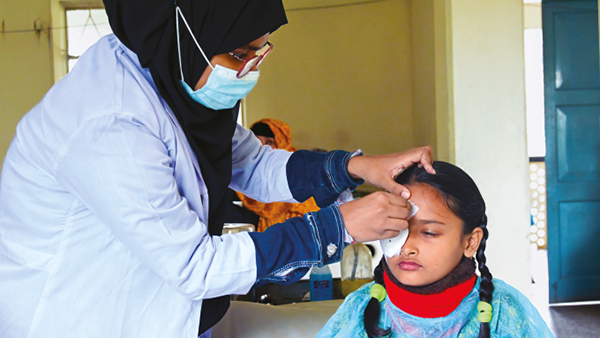You are viewing 1 of your 3 articles before login/registration is required
Tips for Tackling Ptosis
A comprehensive exam of the entire periorbital region involves assessing the health, appearance, and positioning of the eyelids.
A comprehensive eye exam should involve looking at our patients from both a “macro” and a “micro” perspective. My exam starts the moment I enter the room, looking at patients’ outward appearance and posture: How are they sitting? Is there a head tilt? As I begin my conversation, I look at their facial muscles. Are they recruiting their frontalis muscle in their forehead to pull their eyelids up? How are they moving their face? I look for things like blepharoptosis, dermatochalasis, rosacea, dark circles, or volume loss and assess how any of these factors are affecting their eyes.
At the slit lamp, I always have patients look down so I can check for Demodex and see if they wear lash extensions or have telangiectasia – anything that could be hiding underneath that lid! With their eyes closed, I hunt for lumps and bumps because eyelids are the most common place on the body for skin cancer. Last, I push and pull on the lids to evaluate laxity, ensure a good snap test, and take an overall view of any makeup and other products from their normal regimen that may be showing up on their eyes.
Start the conversation
There are two simple ways to tuck a conversation about the lid’s location and concerns such as age-related ptosis into the comprehensive exam: widefield fundus photography and meibomian gland imaging (1). On widefield photography, I might notice that the view is not as complete as it should be because there is a lid in the way. This is a great chance to show patients their lid position and let them know that the lid had to be lifted to get a complete view of their fundus. I tell them that this shows us that the lid is most certainly obstructing part of their visual field. This can then make talking about low-lying lids an easy conversation to have.
Meibography, which is performed on almost all patients in my practice, provides a chance to address lid position at the same time as meibomian gland health. I might point out that the lid is touching the patient’s lashes and discuss what this means. Even though we are evaluating the retina and assessing patients for dry eye – the lid can be a very crucial piece of the puzzle.
I subscribe to the “ask and look, look and ask” mindset. My intake form includes some very specific questions about lids. One – “Do you want your eyes to be more open?” – drives a conversation. Even if patients say no on the form, if I notice a problem, I will ask them specifically, “Have you noticed that your lids are low?” or “Do your eyelids bother you? Do they feel heavy toward the end of the day? Do you find yourself struggling to see at night?”
I might then reach over and gently push the patient’s forehead down, to get the chin properly positioned. This way I can show a patient that he or she is compensating for that low-lying lid with the head position. It is a reset for them. Frequently, patients will bring up the concern directly and indicate that they are troubled by their droopy lids.
Eye-opening eye drops
Many patients, however, do not know that we have treatment options that address their low-lying lids. Upneeq (oxymetazoline hydrochloride ophthalmic solution 0.1%, RVL Pharmaceuticals) is the first FDA-approved product for the treatment of ptosis. These eye drops can elevate the lid by up to 2 mm with one drop that lasts about 8 hours, creating a more open eye and more alert appearance (2, 3, 4, 5).
When patients find out that there is a pharmaceutical that can make their eyes appear more open – or perhaps that they are a good candidate for radio frequency tightening or even surgery – they are extremely grateful. They might not realize that their cosmetic concern can also be a functional impairment. These conversations can be gratifying both for me and my patients.
When patients have said they are interested in having their eyes more open on the intake form, we instill Upneeq in one eye in the office for that “wow effect.” By the time I start my exam, they have one lid lifted and they can see the difference. Dosing patients in this manner works well in my practice; it excites the patients, and it also keeps my staff engaged and ensures the option is at the forefront of their minds, when they are interacting with patients.
I have some patients who use the drop every day, just like drinking their morning cup of coffee, and others who use it for specific occasions, such as a photo shoot, a wedding, or even a night out. Some patients may not be candidates for surgery or have already had a procedure and do not want to repeat it, so they would prefer a non-invasive boost. We can never assume who a typical user might be. Many of my everyday users are older men in high-level, C-suite executive positions. They want to maintain an edge, appear fresh and at their best – not look tired or stressed out.
Complementary products
Patients who are already coming in for aesthetic procedures like Botox (OnabotulinumtoxinA, Allergan) and fillers are always interested in doing what they can to enhance their results. Those patients are “low hanging fruit,” so to speak. Although oxymetazoline is not on-label, I have seen its whitening effects in patients, so I tell them the drop whitens and widens. Some are already taking Lumify (brimonidine tartrate 0.025%; Bausch + Lomb) for that purpose.
When it comes to discussing cost, I like to separate church and state. My technicians and other staff are well educated about our procedures, the products we offer, and the price points – I can rely on them to handle that part of the discussion. We offer Upneeq in the office, and patients can go directly through the manufacturer to have it delivered to their doorstep – making it extremely easy and convenient. I don’t have concerns regarding patients using this drop in addition to others; in clinical trials, no significant issues with dryness were observed (5).
You should tackle ptosis too!
Ptosis is not always just a cosmetic concern; it can affect patients’ field of vision as well as how their eyes feel and function. It is important we assess the health, appearance, and positioning of the lids as part of a comprehensive eye exam that considers all parts of the ocular system and the entire periorbital region. Practicing our profession to its optimal level means ensuring we identify all potential issues for patients before educating them on the range of available solutions.
References
- M Brujic, H Ilyas, “The ultimate guide to Upneeq for eyelid ptosis.” Available at eyesoneyecare.com/resources/the-ultimate-guide-to-upneeq-for-eyelid-ptosis/
- B Esmaeli-Gutstein et al., “Distribution of adrenergic receptor subtypes in the retractor muscles of the upper eyelid,” Ophthalmic Plast Reconstr Surg., 15, 92-99 (1999).
- B Haenisch et al., “Alpha-adrenoceptor agonistic activity of oxymetazoline and xylometazoline,” Fundam Clin Pharmacol., 24, 729-739 (2010).
- CB Slonim et al., “Association of oxymetazoline hydrochloride, 0.1%, solution administration with visual field in acquired ptosis: a pooled analysis of 2 randomized clinical trials,” JAMA Ophthalmol.,138, 1168-1175 (2020).
- DL Wirta et al., “Safety of once-daily oxymetazoline HCl ophthalmic solution, 0.1% in patients with acquired blepharoptosis: results from four randomized, double-masked clinical trials,” Clin Ophthalmol., 15, 4035-4048 (2021).
The New Optometrist Newsletter
Permission Statement
By opting-in, you agree to receive email communications from The New Optometrist. You will stay up-to-date with optometry content, news, events and sponsors information.
You can view our privacy policy here
Most Popular
Sign up to The New Optometrist Updates
Permission Statement
By opting-in, you agree to receive email communications from The New Optometrist. You will stay up-to-date with optometry content, news, events and sponsors information.
You can view our privacy policy here
Sign up to The New Optometrist Updates
Permission Statement
By opting-in, you agree to receive email communications from The New Optometrist. You will stay up-to-date with optometry content, news, events and sponsors information.
You can view our privacy policy here







